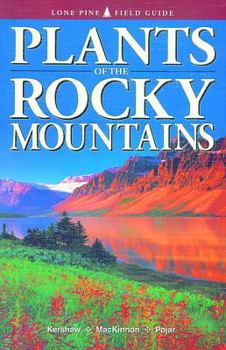Plants of the Rocky Mountains
Over 1300 species of trees, shrubs, wildflowers, grasses, ferns, mosses and lichens are described and illustrated. Notes on origin of name, ecology, native uses, edibility and similar species are... This description may be from another edition of this product.
Format:Paperback
Language:English
ISBN:1551050889
ISBN13:9781551050881
Release Date:June 1998
Publisher:Lone Pine Publishing
Length:384 Pages
Weight:1.26 lbs.
Dimensions:0.8" x 5.5" x 8.5"
Customer Reviews
5 ratings
The one essential guide
Published by Thriftbooks.com User , 19 years ago
I do lots of "belly botany" -- always on my elbows looking at, and photographing, tiny alpine plants in the Rockies -- and I have a vast collection of plant keys and guides. I tell everyone, though, that if they want just one book on all the plant life in the Rockies of Montana, Alberta, Wyoming, and adjacent areas, this is it. Plentiful and clear photos, good "keys" for identifying plants, and just enough detail. This book contains trees, shrubs, herbaceous plants, grasses, ferns, lichens, rushes, sedges, bryophytes, -- everything you need in one low-price volume. I bought two and tore one apart so I could save weight carrying just the flower section when I go backpacking.
A classic in field guides
Published by Thriftbooks.com User , 20 years ago
Indispensible for beginners and experts alike!The book begins with an itroduction that includes info on different zones such as: foothills, montane, subalpine, alpine, disturbed areas, basic maps, wildlife, fires, and more.It then is divided and color coded for example: Trees-brown, shrubs-brown, wild flowers-yellow, grasses-green, ferns and Allies-reddish brown, Bryophytes-light green, lichens-light purple, and glossary-dark purple.Within each section, it is further divided by family. For example the tree section is divided into pine family, willow family, and birch family. At the beginning of this section is a key to help you identify the different families. The flower section includes a photo key, so that you can find the flower you are seeking at a glance, and then go to the correct page. Each plant includes info including common and latin name, description, where found and notes. The notes vary, but include much interesting information on the history of the plant. Some info on edible and medicinal plants is offered as well though the authors state, "This guide is not meant to be a 'how-to' reference for consuming wild plants." It also includes information on other plants in the "family within the family"...for example it discusses 3 different types of Tragopogon (Goat's beard or Salsify). It often gives pictures of more than one plant in the family-within-the family. It has a color photo for each plant, and many of them also include illustrations.I am a beginner, and my purpose in using this book is to study edible wild plants. One thing drew me to this book was that it includes mcuh info on grasses, trees and shrubs. For learning edible wild plants, I also recommend Edible Wild Plants: A North American Field Guide by Elias and Dykeman. This book offers info about poisonous look alikes. Another wonderful aspect of Plants of the Rocky Mountains is its sturdy construction. It is well made, and appears that it will able handle many hiking and camping trips.In summary, I think everyone interested in wild plants could benefit from this wonderful book, particulary at such a great price!
A Fine Resource for the Casual Naturalist
Published by Thriftbooks.com User , 22 years ago
This is an excellent guidebook to the flowers, shrubs, trees and plants of the entire Rocky Mountain chain. I tested this book in the meadows and streambeds near my home in Wyoming and discovered that the photos are clear, colorful, and aid in identification of species. Each listing features a general description as well as data on the leaves, flowers, fruits, and range. If you read the description closely and match it with your subject it's difficult to misidentify the species. Not every wildflower is included here but 95% of what you might find in Yellowstone or RMNP is here. Also, there's a brief bit of lore on most of the more common plants and flowers to help the reader understand the historical medicinal uses, as well as which ones make a refreshing tea and which ones can leave you paralyzed and impotent if ingested at toxic levels.Not to be underestimated is the sturdy construction of this book - I carried it on a 2 week backpack earlier this summer and found the cover virtually indestructible and waterproof.
Amateur (and professional) ecologist's sidekick
Published by Thriftbooks.com User , 24 years ago
"Plants of the Rocky Mountains" is by far the best all-around field guide for Rocky Mountain trees, shrubs and flowers (with some grasses) that I've yet seen, and ranks right up there with classics like Newcomb's Wildflower guide for the northeast. Kershaw et al. provide simple, easy-to-use keys and organize plants by growth form (trees, shrubs, flowers), family, and color, so that both beginners and botanists can navigate with ease. Photographs are typically small, but the entire plant is shown, usually in its native habitat. Descriptions typically include relatives, uses, and occasionally an amusing anecdote.As a cautionary note, "Plants of the Rocky Mountains" is intended to be used in the mountains, and is less useful in deserts, basins, or canyon country. That said, this is the ONE book that I take with me on weekend jaunts in the high country. -William Adair, Department of Fisheries and Wildlife, Utah State University
Excellent plant identification guide.
Published by Thriftbooks.com User , 25 years ago
The guidebook by Kershaw, et al is an excellent reference to plants of the Rocky Mountains. It has quite representative color photos of almost every species mentioned, and there are handy tools to help identify unknown species. The quality of the paper and binding allow for continued use in the field. When I take only one reference guide into the field, it is this one.






